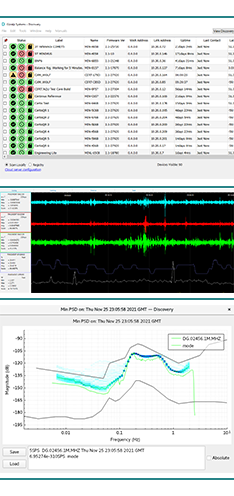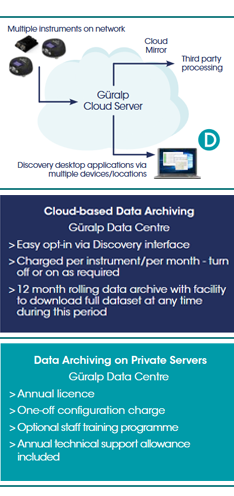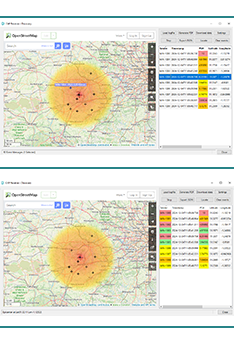Discovery
Applications
- Instrument Management
- Data Quality Assurance
- Event Data
- Access Güralp Data Centre
Available for our Minimus digitisers and Minimus integrated sensors, Discovery offers a single unified interface to a range of powerful tools for managing your seismic instrumentation, archiving your data and monitoring your network state-of-health.
Instrument Management - Easily register and acquire real-time State-of-Health parameters from telemetered systems; remotely update digitiser firmware and upload configuration files to multiple units simultaneously.
Data Quality Assurance - Analyse seismic data for quality and verification purposes.
In addition to the instrument management essentials, at a network level, Discovery acts as a portal to a number of other optional tools and modules that are designed to simplify your network management tasks:
Güralp Data Centre - One-click set-up to record, forward and archive network data; monitor network performance and latency.
Güralp Magna - a comprehensive service for customers seeking to integrate seismic monitoring into their asset management programme. Optional integration of your site-specific fragility data for rapid post-event assessment.

From here you have access to a host of essential tools that enable you to manage your instrumentation and assess the quality of your data:
- Easily identify your instrumentation on the internet or your LAN with no need for fixed IP addresses
- State-of-Health traffic light dashboard for simplified instrument management
- Perform advanced analysis on waveform data, including plotting power spectral density graphs (PSDs) and spectrograms
- Remote update and configuration capabilities
- Time-based data download from SD card or archive data at differing sample rates to streamed data.
- Available for Windows and Linux operating systems

Data on the GDC archive can be accessed a number of ways, including the option to interrogate data from a specific date and time. This solution can easily be set up within Discovery and provides access to network state-of-health tools as well as data forwarding features.
For organisations that require all data archiving to be maintained on their own servers, we can also supply GDC for implementation on your LAN, giving you access to the same features and tools.
- One-click set-up for data archiving in the cloud with access to network management tools
- Remote update and configuration capabilities Time-based data download from archive
- Option to utilise GDC on private servers
- Available for Windows and Linux operating systems
- Added layer of redundancy in data acquisition workflow
- Enables remote and automated State-of-Health reports

Magna provides comprehensive guidance on each of your assets following a seismic event. To leverage the maximum value from the system, we can integrate your existing site-specific fragility data for rapid assessment following an earthquake. We can also undertake bespoke integration with your existing systems to activate emergency protocols in the event of an earthquake above a specified threshold.
- Rapid assessment of geographically dispersed assets following a seismic event
- Option to integrate site specific fragility curves for accurate analysis post event
- Automated alerts and emergency protocols
- Detailed shake maps within seconds of event
- Triggered events displayed on a map using Common Alert Protocol (CAP) reciever
- Cloud-based ‘Desktop as a Service’ solution
- Can be set up on Güralp or private hosted GDC
